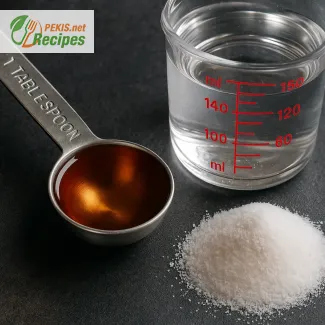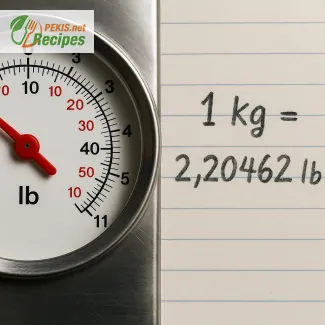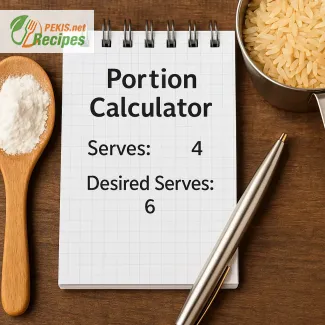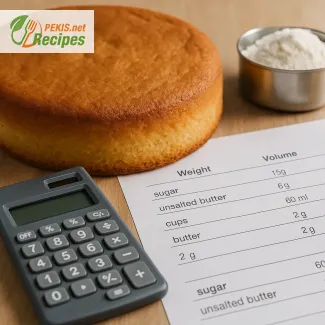
Ultimate guide to converting kitchen units with precision
Everything you need to know about accurate measurement conversions in cooking
Cooking is a blend of creativity and precision. While flavor and texture may come from skill and instinct, accurate measurements ensure consistency in every dish. Whether you're scaling recipes, trying out international cooking instructions, or adjusting portions, knowing how to convert milliliters to tablespoons or grams to cups is essential. This guide helps you navigate the world of kitchen measurement conversions, ensuring your ingredients are always in perfect balance.
Ingredient Conversion Calculator
Why accurate kitchen measurements are crucial
Incorrect measurements can lead to significant differences in taste, texture, and even appearance. A tablespoon too much liquid can ruin a sauce. Too little flour, and a cake may collapse. Precision is especially important in baking, where chemical reactions depend on exact quantities.
Using the correct conversion between metric and US customary units helps bridge global recipe differences. For example:
- 1 tablespoon (US) = 14.8 ml
- 1 cup (US) = 240 ml
- 100 g of all-purpose flour ≈ ¾ cup
Such variations make it important to use a reliable kitchen conversion calculator, which not only eliminates guesswork but also saves time and prevents waste.
Understanding the most common kitchen units
Cooking units differ across regions. Some countries use metric units (grams, milliliters) while others use imperial or US customary units (cups, tablespoons, ounces). Here's a breakdown of the most widely used kitchen measurement units:
Metric units
- Milliliters (ml): Used for liquid volume in most countries outside the US.
- Grams (g): Common unit for weight, especially for dry ingredients.
- Liters (L) and kilograms (kg): Used for larger quantities.
US customary units
- Cups: A common volume measure in the US for both liquids and solids.
- Tablespoons (tbsp) and teaspoons (tsp): Used for small quantities.
- Ounces (oz) and pounds (lb): Used for weight and liquid volume.
Knowing the equivalents between these units is key to making any recipe work regardless of origin.
How to convert milliliters to tablespoons
One of the most searched kitchen conversions is ml to tbsp, particularly for baking liquids or dressings. Here's the standard ratio:
- 1 tablespoon (US) = 14.8 ml
- 1 tablespoon (UK) = 15 ml
- 1 teaspoon (US) = 4.93 ml
To convert ml to tbsp, use this formula:
Milliliters ÷ 14.8 = US tablespoons
Example:
- 30 ml = 2 tablespoons
- 45 ml = 3 tablespoons
This conversion is ideal when a recipe gives quantities in milliliters, but you prefer to measure with a spoon.
How to convert grams to cups
The conversion from grams to cups is not always straightforward because it depends on the ingredient's density. For example, 100 g of sugar and 100 g of flour do not occupy the same volume.
Here are common examples:
- All-purpose flour: 100 g ≈ ¾ cup
- Granulated sugar: 100 g ≈ ½ cup
- Butter: 100 g ≈ ½ cup
This highlights the importance of using ingredient-specific conversion charts or tools. A proper grams to cups converter helps avoid overpacking or underpacking, which is a common issue with flour and other powders.
When to use volume vs. weight in cooking
Understanding when to use volume vs. weight is crucial:
- Liquids are best measured in milliliters or fluid ounces
- Dry ingredients like flour, sugar, or rice are more accurate when measured by weight in grams or ounces
- Soft ingredients like butter or peanut butter can be measured by volume (cups) or weight, depending on your tools
Weight measurements are more precise, which is why professional bakers prefer using digital kitchen scales. However, home cooks often rely on volume-based systems, especially in the US.
Tips for measuring sticky and powdered ingredients
Ingredients like honey, syrup, or peanut butter can stick to your tools. To make your conversions and measurements more accurate:
- Coat spoons or cups with oil or water before measuring sticky substances
- Sift flour before measuring to avoid compaction
- Level off dry ingredients with a knife to ensure consistency
These tips ensure that converted measurements are both accurate and consistent across multiple recipes.
How to convert cups to grams (and vice versa)
To convert cups to grams, you need to consider the ingredient type. Here are some common conversions:
- 1 cup all-purpose flour = 120 g
- 1 cup sugar = 200 g
- 1 cup butter = 227 g
To reverse:
- 100 g flour = about ¾ cup
- 100 g sugar = ½ cup
For liquid ingredients:
- 1 cup water or milk = 240 ml = 240 g
Using a kitchen scale removes the need for guessing and gives the most reliable result when converting cups to grams.
Best practices when using a kitchen conversion calculator
To get the most out of your kitchen conversion calculator, follow these guidelines:
- Always select the correct ingredient type
- Choose accurate unit categories (e.g., volume or weight)
- Double-check values with trusted cooking resources
- Avoid approximations unless you know the ingredient’s density
Modern calculators allow you to customize input units, so you can switch between ml, tbsp, g, oz, cups, or tsp in seconds.
Common ingredient-specific conversion examples
Here are some frequently searched ingredient conversions:
- Olive oil: 1 tablespoon = 13.5 g
- Honey: 1 tablespoon = 21 g
- All-purpose flour: 1 cup = 120 g
- Brown sugar (packed): 1 cup = 220 g
- Milk: 1 cup = 240 ml
- Salt: 1 tablespoon = 18 g (varies by type)
These conversions are invaluable when adapting international recipes to local measuring systems.
Converting small quantities accurately
Small quantities can make a big difference, especially with salt, yeast, or spices. Measuring just 1–2 grams incorrectly can throw off the flavor balance.
Use:
- Digital kitchen scales accurate to 0.1 g
- Measuring spoons labeled in ml
- Conversion tools that allow decimal inputs
Example:
- 1 gram of table salt = ~0.06 tbsp
- 2 grams of dry yeast = ~½ tsp
A precise small quantity converter ensures delicate ingredients are never overused.
Differences between US, UK, and metric systems
Not all measurements are equal globally. Even with the same unit names, the values differ:
- US tablespoon = 14.8 ml
- UK tablespoon = 15 ml
- Australian tablespoon = 20 ml
- US cup = 240 ml
- UK cup = 250 ml (though rarely used in modern UK recipes)
Recipes from different countries must be adjusted based on these unit discrepancies. A universal kitchen calculator should offer region-specific options.
How to use a digital scale in combination with conversion tools
Digital kitchen scales enhance accuracy in conversions. Steps:
- Tare the scale with your container
- Add the ingredient until the desired weight is shown
- Use a conversion chart or calculator to adjust for volume if needed
Scales with unit selection buttons make it easy to switch between grams, ounces, and ml.
Useful tools to simplify measurement conversions
Here are the tools that every kitchen should have for easy and fast conversions:
- Digital kitchen scale (with multiple unit options)
- Measuring spoons and cups (metric and US)
- Printable conversion charts
- Online kitchen conversion calculators
- Mobile apps with ingredient-specific data
Having these at your fingertips ensures your kitchen workflow remains smooth and precise.
Cooking internationally? Why conversions matter even more
If you're exploring recipes from another country, knowing how to convert international units is vital. For example:
- A French recipe might list "100 g de beurre" (butter), but you need to know it’s ~½ cup
- An American recipe calling for "1 stick of butter" translates to 113 g
- An Italian dish using "250 ml di latte" becomes just over 1 cup of milk
Understanding these international cooking conversions avoids confusion and ensures recipe success.
The role of density in ingredient conversions
Not all ingredients weigh the same per cup. That’s why density plays a critical role. For example:
- 1 cup of flour = 120 g
- 1 cup of honey = 340 g
- 1 cup of chopped nuts = 150–170 g
When converting between volume and weight, always consider ingredient density or use ingredient-specific databases.
How to build your own ingredient conversion reference
Creating a personalized chart for the ingredients you use most is smart:
- Choose the top 20 ingredients in your kitchen
- Use a scale and standard cup/spoon set to measure
- Note down both volume and weight results
- Keep this chart handy when converting recipes
This helps especially when baking or adapting family recipes written in one unit system.
Embedding a conversion calculator into your kitchen routine
The easiest way to streamline conversions is to integrate a calculator into your cooking process:
- Keep a conversion chart on your fridge or cupboard
- Use a mobile calculator app while shopping or cooking
- Print out ingredient-specific conversion tables
These small habits reduce confusion and increase your confidence in following recipes accurately.
Ideal for beginners and pros alike
Whether you're just starting to cook or are an experienced chef, mastering kitchen conversions gives you:
- Greater recipe flexibility
- Improved accuracy
- The ability to cook dishes from any country
- Better control over portion sizes and nutrition
Investing time in learning these conversions pays off with delicious and repeatable results every time you cook.


